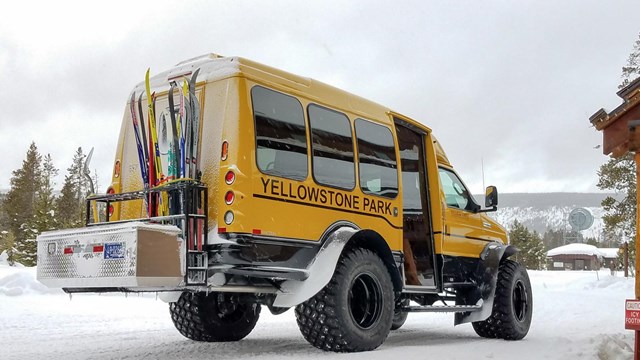
NPS/Neal Herbert The popularity of visiting the park in winter, coupled with concerns over impacts to resources from visitation, has made winter use planning for Yellowstone one of the most contentious issues for park managers and visitors. The debate spans more than 80 years, with each participant asking: should the park be accessible in winter? If so, what type of transportation has the least harmful impact on resources, while providing for meaningful visitor experiences? In the early 1930s communities around the park began asking the NPS to plow Yellowstone’s roads year-round so tourist travel and associated spending in their communities would be stimulated. Each time, the NPS resisted these requests citing non-winterized buildings, harsh weather conditions, and roads too narrow for snow storage. Meanwhile, snowbound entrepreneurs in West Yellowstone began experimenting with motorized vehicles capable of traveling over snow-covered roads. In 1949, they drove the first motorized winter visitors into Yellowstone in snowplanes, which consisted of passenger cabs set on skis and blown about (without becoming airborne) with a rear-mounted airplane propeller and engine. In 1955, they began touring the park on snowcoaches (then called snowmobiles), enclosed oversnow vehicles (OSV) capable of carrying about 10 people. Finally, in 1963 the first visitors on modern snowmobiles entered Yellowstone. Not long after, snowmobiling became the dominant way to tour the park in winter. Still, pressure to plow park roads persisted, and Yellowstone authorities knew that they could not accommodate both snowmobiles and automobiles. The matter culminated in a congressional hearing in Jackson, Wyoming, in 1967. By this time, park managers felt plowing would dramatically alter the look and feel of the park’s winter wilderness. They thought snowmobiles offered a way to accommodate visitors while preserving the winter time experience. By 1968, an OSV program was formalized. In 1971, park managers began grooming snowmobile routes to provide smoother, more comfortable touring, and also opened Old Faithful Snow Lodge so visitors could stay overnight at the famous geyser. Throughout the 1970s, 80s, and early 90s, visitation by snowmobile grew consistently. This brought unanticipated problems such as air and noise pollution, conflicts with other users, and wildlife harassment. Meanwhile, in 1972, President Nixon signed Executive Order 11644 which described how off-road vehicles, including snowmobiles, should be managed. This Executive Order requires each agency to: establish policies and provide for procedures that will ensure that the use of off-road vehicles on public lands will be controlled and directed so as to protect the resources of those lands, to promote the safety of all users of those lands, and to minimize conflicts among the various uses of those lands. In 1990, park managers completed the Winter Use Plan Environmental Assessment for Yellowstone and Grand Teton national parks and the John D. Rockefeller, Jr. Memorial Parkway to address known and developing problems with snowmobile use. This plan formalized the park’s existing winter use program and included a commitment to examine the issue further if winter visitation exceeded the threshold of 140,000 visitors. That threshold was exceeded in the winter of 1992–1993, eight years earlier than the plan predicted. In accordance with the 1990 plan, the NPS began an analysis of all types of winter recreation on all NPS and Forest Service (FS) lands in the greater Yellowstone area. Park and forest staff used scientific studies, visitor surveys, and public comments to analyze the issues or problems with winter use. The final report, Winter Use Management: A Multi-Agency Assessment, published in 1999, made many recommendations to park and forest managers and summarized the state of knowledge regarding winter use at that time. Unfortunately, the assessment did not change conditions in the parks. By the late 1990s, an average of 795 snowmobiles entered the park each day. All were two-stroke machines, which used a mix of oil and gas for combustion, resulting in high levels of pollution. Carbon monoxide pollution was especially severe, coming close to violating the Clean Air Act’s standards at the West Entrance in one event. Air particulate and some hydrocarbon levels were also high. Two-stroke machines were also loud, making it difficult to experience natural silence in the Firehole Valley on many days. Many visitors traveling by snowmobile lacked the experience necessary to pass bison and other wildlife without causing harassment. 
Winter Use Planning and Litigation
Learn more about the long history of winter use planning and litigation in the park. 
Winter Use Management Archive
Read the various winter use management and planning documents. 
Winter Use Management
The final Rule authorizing oversnow-vehicle use in Yellowstone was published in the Federal Register on October 23, 2013. |
Last updated: April 18, 2025
